 |
|
Albas |
Welcome to the September edition of my web site. The roses I write about are the Old Garden Roses and select shrub and miniature roses of the 20th century. For tips on rose culture, pruning, propagation and history, see "Other resources on this site". To return to this page, click on the "thorn icon" in the margin at left. Articles from the previous months are archived and can be viewed by clicking on the listings in the left margin. Oh, and please don't write to me for a catalog or pricelist.....this is an information site only.....not a commercial nursery. If you wish to buy roses, see my sponsor, The Uncommon Rose. Thanks! "Coffee
Roses " A little outside the traditionally accepted range of rose colors lies a group of "special" varieties. They may not be what you would choose to include in the front-line rose garden as they might appear a bit drab among all their more brightly colored brethren.
Eugene Boerner's stroke of genius of crossing GREY PEARL with Kordes' PINOCCHIO resulted in the 1948 floribunda LAVENDER PINOCCHIO. The buds remain ovoid but the flowers come in small clusters rather than singly, so there is more pleasure to be enjoyed. They are often the color of hot cocoa, sometimes shaded olive and darker pink-brown, and have a good, spicy fragrance. These mature to pink-lavender in the cupped bloom of 25-30 petals showing many golden stamen. These look lovely combined with flowers of pale gold. Kordes, working with LAVENDER PINOCCHIO, introduced his rich floribunda CAFE in 1956. CAFE should be quite cold hardy being also bred from the Brownell's lame flowered climber GOLDEN GLOW and R. Kordesii. The name is appropriate as the usual color is that of fresh coffee with half and half. The blooms are very full and flat with a sweet fragrance. They often appear in clusters of three and are contrasted beautifully by the olive green foliage. CAFE adds rich tints to bouquets of autumn colored blooms and foliage. 1959 saw one of the most unusual and variable introductions in Boerner's floribunda BROWNIE. He used a LAVENDER PINOCCHIO seedling pollinated by GREY PEARL to produce a floral arranger's dream in a brownish-tan bloom with a golden reverse and bright golden stamen. The brown begins to warm and the yellow fades as the flowers mature until they are bright red with white reverse. There are a little under forty petals in the 3˝" to 4" blooms and they appear in nice cuttable, fragrant clusters. England's Edward LeGrice developed a reputation for producing roses of unusual colors. He brought out the heavenly scented floribunda AMBERLIGHT in 1962. He was hybridizing along some unusual lines, using a seedling crossed with LAVENDER PINOCCHIO, the result crossed with the velvety scarlet-purple gallica MARCEL BOURGOUIN. Sound familiar? He called the 26 or so ruffled, clear amber petals "Egyptian Buff". The large 3˝" to 4" blooms are richly fragrant with what LeGrice described as "a heavy honey scent". It is strong and sweet, words being insufficient to describe it. It is quite free blooming and cuttable.
In 1966 LeGrice introduced his floribunda VESPER. The slightly fragrant, double open blooms are a cool, pastel orange-brown and are beautifully contrasted by the dark, blue-gray-green foliage. His 1970 introduction was the floribunda JOCELYN (upper left). It is a short grower, producing 3" very full, flat flowers of a rich, dark mahogany and brick red flushed purple. JOCELYN is very thorny with short stems and dark holly-like foliage. The color is unique and very characteristic. Once seen, you will remember it well.
Jackson & Perkins introduced the hybrid tea SMOKY in 1968. It is double, loose flower of about 3˝"to 4" in what they call "oxblood-red shaded burgundy" It is about as good a description as I could come up with. There is some fragrance and the stems can be long and strong enough for cutting. The petals form a gray "bloom' like that of a grape and become rather unattractive before they drop. In their prime, they give rich shadows to other blooms. Meilland brought out FANTAN, one of the earliest brown hybrid teas, in 1959. The olive and chocolate buds open to 3˝" slightly fragrant blooms of about forty-eight petals. The color ranges from burnt orange through cinnamon to yellow ochre and buff. The short petalled flowers can be unbelievably beautiful. Of all the coffee roses I've grown, FANTAN most benefits from the best culture you can give it. The
hybrid tea, JULIA'S ROSE, came out of England's Wisbech Plant Company
in 1976. Reportedly, it delivers only 2.5” flowers and slowly grows
to a small bush. I've always given it the best and it built up to over
six feet in three years. It is in constant bloom with up to 4" flowers
of only about 22 petals with no discernible fragrance. But the color
of those petals! The official description is "copper and parchment shades".
This is one of the truest browns you can find. From its pointed buds,
warm weather brings out the pink tints, while the cool temperatures
induce warm, rich, deep brown tones. The stamens are golden and the
pistils are bright red. JULIA'S ROSE provides some of the richest and
most sophisticated arrangements you can dream of. Several years after I began growing JULIA'S ROSE (at left), the upper eighteen inches of the bush began throwing cool, golden yellow blooms. I have isolated the sport, and it is now registered as GOLDEN JULIA. The flower and plant look and perform just as the original, except it appears to have lost a gene for pink. The new foliage shows none of the burgundy tints of its parent, nor do the petals display any of the pink shadings, which are necessary to produce the copper pigments of JULIA'S ROSE. It's a very unusual, almost cold yellow, that assorts beautifully with the rest of these sophisticated roses. KIM'S CREAM is a seedling of LAVENDER PINOCCHIO I selected and registered in 1991. It is a very fragrant, floriferous floribunda with clusters of three to five, 3" to 4" blooms. The ovoid, pointed buds begin as a rich coffee-gold-cream, slowly unfurling the 26-40 petals, until the flower opens, showing the many, fine, gold stamen. The coffee and gold tints hold well in the shade or cool weather. High heat causes them to pale to a rich cream. It's a soft, elegant shade that sets off the medium green, semi-glossy foliage to good effect. This one is much like a lighter shade, AMBERLIGHT.Though KIM'S CREAM hasn't been offered commercially, it is being grown in the Heritage Rose Garden in San Jose, California. In 1995 I was visiting the garden and Tom Liggett, the moving force behind it. Many of the unusually colored roses had come from my garden, and as some had lost their labels, I was asked to assist in identifying them. Tom was very impressed with KIM'S CREAM, and asked if I could tell him what it was. I was excited that my rose had done so well for them and was so well liked.
TANTARRA is one whose creator I have the pleasure to know. Bernard Gardner lives in Los Banos, California, and has been breeding roses for his interest and enjoyment for many years. One of his intense rose interests is the creation of these unusual colors. TANTARRA was bred from Boerners 1955 hybrid tea BALINESE, itself a product of GREY PEARL and LAVENDER PINOCCHIO. Its leaves are matte, dark blue-green, yielding a lovely background for the 4", slightly fragrant, creamy tan-mahogany blooms. While they often come one to the stem, small clusters of up to three are produced. The buds are more slender than others from this line of breeding, and the flower starts off nicely high-centered. Like the others of this coloring, the rich, creamy coffee shades are most evident in cooler weather or light shade. The only climber in the group is William Warriner's BUTTERSCOTCH, introduced in 1986. It's a very strong grower with light green foliage and dark, bright red new shoots and prickles. Blooming starts early and is fairly continuous. Most of the blooms appear in small clusters on fairly long stems. The pointed buds open to loose-cupped 3" to 3-1/2” blooms. They are buff in warm weather but cooler temperatures bring out the rich butterscotch-pudding shades. The slight fragrance impresses me of being derived from R. Foetida. Having enjoyed the gray and brown roses, it's now time to look at the green varieties: Jack Harkness brought out his incredible floribunda GREENSLEEVES in 1980. Of very mixed parentage, including ELIZABETH OF GLAMIS and PASCALI, it produces small to huge clusters of dark, bright pink pointed buds opening to 2˝" to 3" blooms of about 15 wavy petals. They begin light pink and quickly mature to light green-tinted white, then to the color of a Granny Smith apple with light greenish-yellow stamen and pollen. The growth is strong, tall and thorny, with bright green, almost rugose foliage. The clusters are best cut when young while fairly tight, pink buds. The blooms will open and will develop their incredible green shades in water.
(at left: 'Teddy Bear') TABLE MOUNTAIN is a pink and green blend hybrid tea from the House of Kordes. It was introduced by Ludwig's Roses in South Africa, and has taken a few years to make it to the United States. My plant has stayed short, about two feet, and provides an acceptable amount of bloom. The stems are fairly long, seldom carrying more than one, 4", very double bloom each. The buds are long and of a very good shape. They begin a dark, greenish-pink, maintaining a high-centered, almost exhibition shape, with no fragrance. The.pink darkens and the outer petals start to develop strong, bright green pigments. The green underlay and accents provide a brilliance and intensity to the pink. The overall effect is rather startling and dramatic. TABLE MOUNTAIN isn't registered, so I can't share any information on how it was created. Jack Christensen's 1983 hybrid, tea, MINT JULEP, rounds out the group. It has been a tall grower with large, dark foliage in my garden. It really is what you would expect of a bush produced from QUEEN ELIZABETH and WHITE MASTERPIECE. The long buds come singly and in clusters of up to five, with long sepals and strong stems. The blooms are up to 5", high-centered, and slowly spiral open their 35 large petals of soft apple-green and pale pink. There isn't any fragrance, but the form and color will last up to two weeks in water. As these roses develop chlorophyll in their petals, providing sufficient iron will ensure the best color. You may also find it beneficial to sprinkle Diazanon granules around the base of these green roses as the chlorophyll in the petals also makes them favorites of aphids and their attendant ants.
COFFEE COUNTRY, a new russet hybrid tea just introduced this year and only available in very limited quantities. The ranks of the coffee miniatures are swelling every day, but that is another story. There are unique highlights and contrasts to be had using these muted blooms to provide rich depth and shadows not generally available in our rose palette. Combine the warm russets with golden blooms and other warm colors and autumn foliage in crystal, copper or wood; the cool ones with clusters of hoya, lavender and blue blooms, sprays of silver and gray Dusty Miller and other examples of floral moonlight in marble, pewter, crystal or silver boxes, vases or pitchers. Let your creativity and imagination run wild. Treat yourself to the feast of subtlety and sophistication only these coffee roses can afford. Copyright 2000 Kim Rupert
There
have been |
|

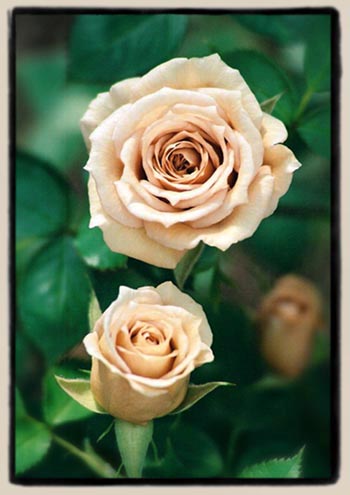
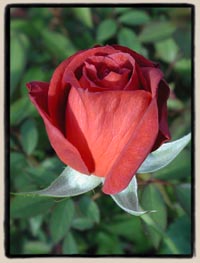
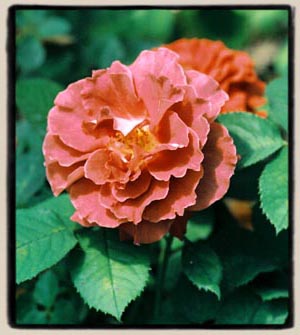 One
of his last floribundas in these coffee shades was VICTORIANA (at
right), introduced in 1977. The bloom is large, to 5", with about
25 wavy petals in a dark, cool orange flushed and veined purple and
maroon with a silvery-white reverse. The purple shadings begin forming
at the petal edges and give the impression of a smoke or haze over the
rich, dark orange. The effect is a medium to dark russet-brown. This
and JOCELYN are two of the hardest to describe as their colors are so
complicated and unusual.
One
of his last floribundas in these coffee shades was VICTORIANA (at
right), introduced in 1977. The bloom is large, to 5", with about
25 wavy petals in a dark, cool orange flushed and veined purple and
maroon with a silvery-white reverse. The purple shadings begin forming
at the petal edges and give the impression of a smoke or haze over the
rich, dark orange. The effect is a medium to dark russet-brown. This
and JOCELYN are two of the hardest to describe as their colors are so
complicated and unusual. 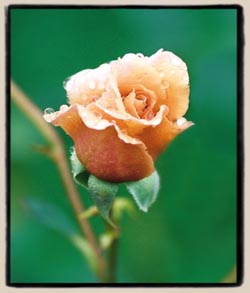
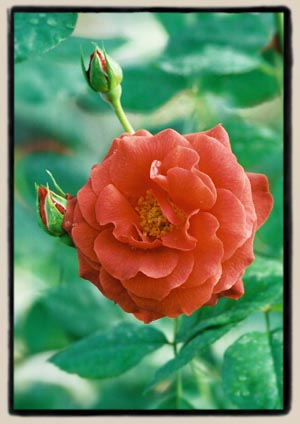 Sam
McGredy brought out his luscious floribunda BROWN VELVET (at right)
in 1982. This has been nearly disease free and a strong grower for me,
producing canes which seem to want to climb. The dense foliage is very
glossy and very dark green. The ruffled blooms have about 35 petals
with little fragrance in the garden. Opening the flowers in a warm room
allows a very sweet, quite masculine scent to develop. I had grown this
for many years before a friend with whom I had shared a plant, introduced
me to its fragrance. Warm weather gives you loads of bright orange blooms
in large, very full clusters. At this stage it is pretty. But, when
the nights start to cool and the days get short, the bloom and cluster
sizes increase, the dark foliage intensifies and the new growth turns
a delicious cranberry. The bright orange petals develop a purple velvet
over the surfaces while the bases remain orange blending to yellow at
the center with bright yellow stamen. The way I see them at this stage
is Hershey-bar chocolate brown velvet petals swirling around a glowing
ember. There is no describing the rarity and depth of a mature, developed
cluster in a vase.
Sam
McGredy brought out his luscious floribunda BROWN VELVET (at right)
in 1982. This has been nearly disease free and a strong grower for me,
producing canes which seem to want to climb. The dense foliage is very
glossy and very dark green. The ruffled blooms have about 35 petals
with little fragrance in the garden. Opening the flowers in a warm room
allows a very sweet, quite masculine scent to develop. I had grown this
for many years before a friend with whom I had shared a plant, introduced
me to its fragrance. Warm weather gives you loads of bright orange blooms
in large, very full clusters. At this stage it is pretty. But, when
the nights start to cool and the days get short, the bloom and cluster
sizes increase, the dark foliage intensifies and the new growth turns
a delicious cranberry. The bright orange petals develop a purple velvet
over the surfaces while the bases remain orange blending to yellow at
the center with bright yellow stamen. The way I see them at this stage
is Hershey-bar chocolate brown velvet petals swirling around a glowing
ember. There is no describing the rarity and depth of a mature, developed
cluster in a vase.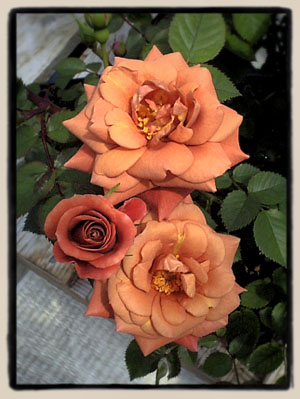
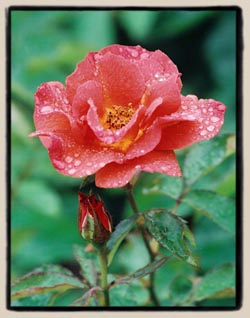 There
are new additions to this special group such as the russet floribundas
IRIS WEBB and the EDWARDIAN LADY (at right), EDITH HOLDEN, both
by England's Chris Warner; Cocker's GINGERNUT and the russet hybrid
tea GEORDIE LAD and floribunda WHICKHAM HIGHWAY by Collin Homer (of
CHAMPAGNE COCKTAIL fame); George Wilson's russet hybrid tea CATHY ANNE;
Bossom's green floribunda PEPPERMINT ICE; Sheldon's russet hybrid tea
O'RILLA; and Simpson's russet floribunda HOT CHOCOLATE, from New Zealand.
None of these are available to us yet. William Warriner's tan floribunda
TOPAZ was available from Hortico in Canada for a season, but no longer.
Japan's Mr. Okamoto produced a russet hybrid tea called BLACK TEA. It
was available overseas in both bush and climbing forms. Sam McGredy
brought out his russet hybrid tea OLD SPICE (VIDAL SASSOON in Europe)
which has only recently become available here, but hasn't yet caught
up to the demand.
There
are new additions to this special group such as the russet floribundas
IRIS WEBB and the EDWARDIAN LADY (at right), EDITH HOLDEN, both
by England's Chris Warner; Cocker's GINGERNUT and the russet hybrid
tea GEORDIE LAD and floribunda WHICKHAM HIGHWAY by Collin Homer (of
CHAMPAGNE COCKTAIL fame); George Wilson's russet hybrid tea CATHY ANNE;
Bossom's green floribunda PEPPERMINT ICE; Sheldon's russet hybrid tea
O'RILLA; and Simpson's russet floribunda HOT CHOCOLATE, from New Zealand.
None of these are available to us yet. William Warriner's tan floribunda
TOPAZ was available from Hortico in Canada for a season, but no longer.
Japan's Mr. Okamoto produced a russet hybrid tea called BLACK TEA. It
was available overseas in both bush and climbing forms. Sam McGredy
brought out his russet hybrid tea OLD SPICE (VIDAL SASSOON in Europe)
which has only recently become available here, but hasn't yet caught
up to the demand. 